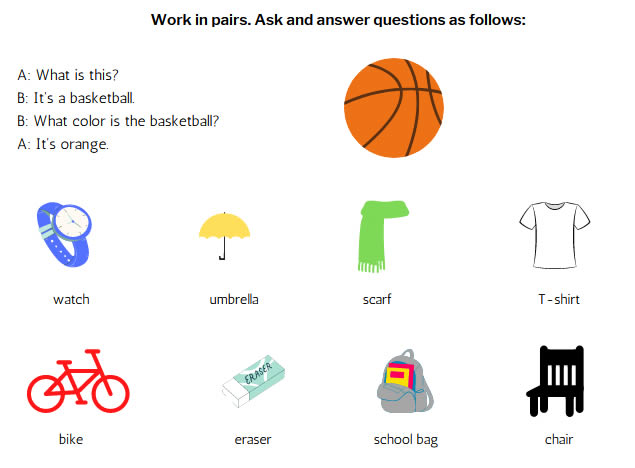This is a detailed description of a definite and indefinite articles lesson plan. It is a step by step
Table of Contents
You may find the worksheet about the definite and indefinite articles In English in a PDF format by following this link:
Introduction
Definite and indefinite articles in English are small words that may pose problems for beginners. This lesson plan is designed to help them discover by themselves the main use of these articles. The lesson starts with a short dialogue.
After a short meaning-focused activity, this lesson plan leads the students to discover the rules by themselves and practice their use in well-designed grammar exercises.
The last activity of the lesson plan is meant to let the students practice the articles in a less controlled way.
Starter (Start with a context)

Teaching grammar is best done through context. This can be in the form of a text, dialogue, video, situation, or audio file.
To teach definite and indefinite articles in English, this lesson plan starts with a conversation in which the target language is highlighted.
Since the lesson is meant for beginners, the language is not too difficult for them to understand. The aim here is not reading comprehension per se; the conversation is just a means to highlight the target language.
Before the students start reading, you may want to give them a focus question to be answered while reading silently. For example, you may ask your students to read the exchange and answer the question below:
A. Who likes the movie the most, Jane or Alan?
Here is the text
The special effects are
not realistic
Jane: How do you feel about yesterday’s movie? I think it is an absolute success.
Alan: Yes, I agree. It is an interesting movie about love, a thrilling story. But I’m afraid it is a flop in terms of special effects.
Jane: But the story is breathtaking! Don’t you think so? The movie is an adaptation of Tolstoy’s novel “Anna Karenina.“
Alan: I like the novel, too! I am a fan of Tolstoy’s
style of writing. But still, I find the special effects
not realistic enough.
After answering the focus question, you may invite them to do a short true or false exercise to make sure they understand the text:
B. Are these statements true or false? Justify your answer.
- Jane and Alan are in the movie theatre now.
- Both Jane and Alan like Tolstoy’s novel.
Discovering the use of definite and indefinite articles
After the short reading activity, it is high time to start exploring grammar. The teacher may devise guiding activities that help students discover the rules of form and use.
- First, the students are invited to identify the parts of speech of the words a/an and the.
- Then, the teacher asks them to study the instances of the articles in small groups and sort them out into two categories definite and indefinite.
- They are then invited to read a short grammar summary and match parts of sentences that describe the rules governing the use of definite and indefinite articles.
To identify the part of speech of the target language, the teacher asks the students to do the following activity:
C. What parts of speech are the words in bold (a, an, the)? Choose one of these options:
- Nouns
- Verbs
- Adjectives
- Adverbs
- Articles
- Prepositions
Then, to draw their attention that sometimes we do not use articles before some nouns, the teacher asks the students to study some examples and do an activity to notice and identify the instances where we do not use articles.
D. Read these sentences and notice that there is no article before the nouns in bold.
- He lives in Washington near Mount Rainier.
- She eats cookies.
- Do you like mutton?
E. Match the following:
| 1. Washington 2. Mount Rainier 3. Cookies 4. Mutton | a. Uncountable noun b. Plural noun c. Mountain d. Country, city, or state |
To guide the students to sort out the articles into definite and indefinite, the teacher devises the following activity:
F. Complete this chart with a, an, or the:
| Definite articles | Indefinite articles |
|---|---|
| … | … |
The next step is to ask the students to work in groups, read a grammar summary, and match sentences that describe the rules:
G. Read the grammar summary at the end of this worksheet and match the numbers with the letters to complete the rules:
| 1. The indefinite article “a/an” is used… 2. The indefinite article “a” is used… 3. The indefinite article “an“ is used… 4. The definite article “the“ is used… 5. We generally do not use any… | a. before a consonant sound. b. when we don’t specify the things or people we are talking about. c. when the speaker talks about a specific object that both the person speaking and the listener know. d. plurals, uncountable nouns, countries, states, counties or provinces, lakes, and mountains. e. before a vowel sound. |
Practice
At the practice stage, the teacher invites the students to do some exercises to make sure they apply the rules appropriately and to help them automatize the use of articles.
The practice exercises are sequenced from easy to more challenging.
H. Fill in the sentences with a, an, or the:

I. Complete with a/an or the:
- This is … lamp. … lamp is green.
- This is … door. … door is brown.
- This is … umbrella. … umbrella is blue.
- This is … basketball. … basketball is orange.
J. Complete with a, an, or the where necessary. If no article is needed, mark it with an (X):
- I am going to buy … pair of shoes.
- I am in … Japanese restaurant. … restaurant serves good food.
- Look at … woman over there! She is … famous actress.
- This is … girl I told you about.
- John traveled to … Mexico.
- The kids are sitting at … kitchen table eating cereals.
- Juan is … Spanish.
Over to the students
This is the last stage of the definite and indefinite articles lesson plan.
After practicing the use of the article, it is high time for the learners to use it in a less controlled activity.
K. Work in pairs. Ask and answer questions as follows:

Final Thought
To help the students learn by themselves, it is a good idea to provide them with the data and the necessary tools to explore the language and discover the rules while working in small groups.
For example, before doing activity G above, ask them to read a grammar summary about definite and indefinite articles, working in small groups.
BUY this lesson plan worksheet in PDF format for just $1



